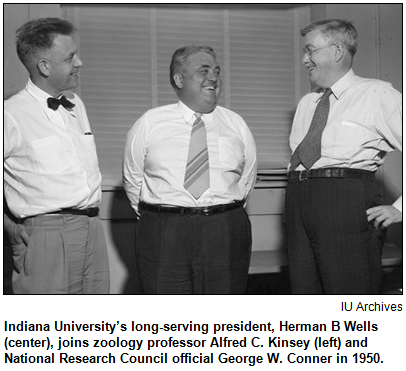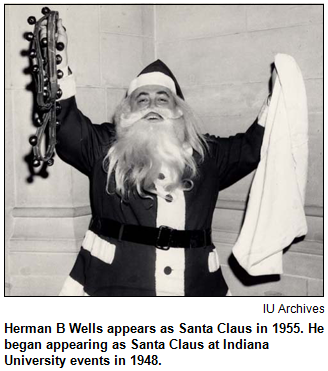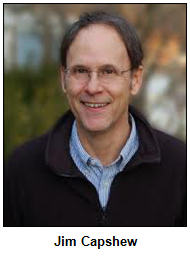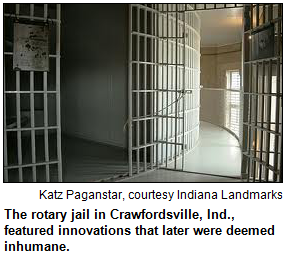You can listen to Hoosier History Live! live on the air each Saturday, or listen online at the WICR website during the broadcast on any computer with speakers, anywhere, or on a smartphone. We invite you to visit our website!
May 12 show
Remarkable life of Herman B Wells
 For six generations, he was "Mr. IU" - the pre-eminent personality associated with the Bloomington campus of Indiana University. Beloved for his jovial disposition and nationally acclaimed as a visionary, Herman B Wells had a glorious life, but also a much more complex one than many admirers realized.
For six generations, he was "Mr. IU" - the pre-eminent personality associated with the Bloomington campus of Indiana University. Beloved for his jovial disposition and nationally acclaimed as a visionary, Herman B Wells had a glorious life, but also a much more complex one than many admirers realized.
As an eagerly anticipated new biography points out, a pattern of suicides ran in the family of the rotund, gregarious educator whom many Hoosiers likened to Santa Claus. (During his run as IU president from the 1930s to the early 1960s - and then for an additional 35 years as the chancellor - Herman B Wells donned a white beard to portray St. Nick during holiday seasons.)
To explore the long life (1902-2000) of the man whose other nicknames included "Hermie," Nelson will be joined in studio by James Capshew, who first met the legendary figure when he was hired in the late 1970s to work as the chancellor's houseboy.
 Today, Jim is an associate professor of history and philosophy of science at I.U. as well as the author of Herman B Wells (I.U. Press), a biography that also describes social history as it unfolded during the 97 years that Dr. Wells lived.
Today, Jim is an associate professor of history and philosophy of science at I.U. as well as the author of Herman B Wells (I.U. Press), a biography that also describes social history as it unfolded during the 97 years that Dr. Wells lived.
Jim's book details Herman B Wells' stealth-like, crucial roles in racially integrating aspects of IU ranging from the Commons dining facility in the student union to the basketball court and the swimming pool.
Dr. Wells also used his clout to defend sex researcher Alfred Kinsey, whose work at IU came under fire in the 1950s.
"Either you have academic freedom or you don't," Dr. Wells told Nelson, our host, who includes him in his book Indiana Legends: Famous Hoosiers from Johnny Appleseed to David Letterman. "There is no compromise. Without it, you don’t have a university. You have a trade school."
Describing Herman B Wells as "empathetic, shrewd and charming," Jim Capshew writes: "Wells built an institution, and, in the process, became one himself."
When Wells, a native of Boone County and a fifth-generation Hoosier, arrived as a student at IU in 1921, the student body totaled 2,500; more than 90 percent were from Indiana. The size and demographics of the student body - along with a staggering array of other aspects of I.U. - were about to be transformed.
Barely 35 years old in 1937 when he was named IU president (initially on an interim basis), Herman B Wells was the youngest college president in America then. He already had made a statewide name for himself by helping put together what Jim Capshew calls "a comprehensive reform package" that helped save Indiana's banks during the Great Depression.
 His father, Granville, was a banker in Lebanon who had been a schoolteacher, as had Wells' beloved mother, Bernice, who became a familiar figure to generations of IU students. ("Mother Wells" lived with her son, a lifelong bachelor, until her death.)
His father, Granville, was a banker in Lebanon who had been a schoolteacher, as had Wells' beloved mother, Bernice, who became a familiar figure to generations of IU students. ("Mother Wells" lived with her son, a lifelong bachelor, until her death.)
As Jim, our guest, recounts in his new book, Granville Wells suffered from a mood disorder, was often "withdrawn and morose" and killed himself in the 1940s. More than 30 years earlier, when Herman was 12 years old, his paternal grandmother had committed suicide.
In contrast, Jim writes, Herman B Wells "projected radiant savoir faire," exhibited tremendous interpersonal skills and had a remarkable memory for names and faces.
An opera lover who had been an economics professor before becoming an administrator, Dr. Wells often is credited as the impetus for elevating IU's music and business schools by, among other things, courting outstanding deans to Bloomington.
In the aftermath of World War II, Wells took a leave from the IU presidency to serve as a cultural affairs advisor in the reconstruction of Europe. About the same time, Dr. Wells prevailed on IU's basketball coach, Branch McCracken, to recruit Bill Garrett, an African-American high school basketball star from Shelbyville, thereby shattering the color barrier in Big 10 basketball.
 When Dr. Wells was awarded his honorary doctorate, IU's trustees praised him as an "educator, statesman, leader of men, devoted Hoosier and also a wise citizen of the world."
When Dr. Wells was awarded his honorary doctorate, IU's trustees praised him as an "educator, statesman, leader of men, devoted Hoosier and also a wise citizen of the world."
Some fun facts:
- Surprisingly, young Herman B Wells was not a distinguished student during his undergrad years in the 1920s. According to Jim Capshew's biography, his grades primarily were Bs and Cs.
- Jim's book also describes how, at age 15, Herman B Wells suffered from a severe case of the mumps that left him with persistent groin pain for several years.
- Jim Capshew grew up in Bloomington. Early in his tenure as Dr. Wells' houseboy, he escorted the legendary educator to the Brown County Playhouse - and watched in awe as fellow theater-goers spontaneously gave his boss a prolonged standing ovation.
History Mystery
Because of his distinguished career and undeniable impact, Herman B Wells received honorary degrees, including an honorary doctorate from Indiana University.
Despite that, another influential and famous Hoosier - not Herman B Wells - is listed in the Guinness Book of World Records as having more honorary degrees than anyone in the world.
Question: Name the famous Hoosier.
To win the prize, you must call in with the correct answer during the live show and be willing to be placed on the air. Please do not call if you have won a prize from any WICR show during the last two months. The call-in number is (317) 788-3314, and please do not call until you hear Nelson pose the question on the air.
This week's prize is a gift certificate to any of the Occasions Divine restaurants, which include Serenity, Serendipity 2, Signature, and Scrumptious, as well as an overnight stay at University Place Conference Center and Hotel on the IUPUI campus. These prizes are courtesy of the ICVA.
Roadtripper: Rotary Jail in Crawfordsville
Roadtripper Chris Gahl of the ICVA tells us that Indiana boasts the only known working "rotary jail" still in existence. Mother may have had something different in mind when you told her you'd take her out for a "spin," but the Montgomery County Rotary Jail Museum is off I-74 west of Indianapolis in Crawfordsville. The unique jail first opened in 1882.
 Builders William H. Brown and Benjamin F. Haugh of Indianapolis believed their patented design would help maintain strict Victorian social order by limiting personal contact between inmate and jailer.
Builders William H. Brown and Benjamin F. Haugh of Indianapolis believed their patented design would help maintain strict Victorian social order by limiting personal contact between inmate and jailer.
Prisoners were put in 16 pie-shaped cells housed in large cylinder which literally spun around with a hand crank. The jailer could rotate the large cylinder, positioning one of the 16 cells in front of a stationary door opening, allowing the jailer to move an inmate in or out one at a time while the other prisoners were facing a wall.
Decades later, however, the jail was deemed unsafe, unsanitary and inhumane, and in 1967, after numerous condemnations by inspectors, a Montgomery County grand jury ordered the structure abandoned.
Both the jail and jailer's magnificent two story Eastlake-design home attached to the jail are now open as the Rotary Jail Museum. It is open Wednesday through Saturday from 10 a.m. to 3 p.m.; check the museum's website for details.
You can also view a current video of the rotating jail.
Your Hoosier History Live! team,
Nelson Price, host and creative director
Molly Head, producer, (317) 927-9101
Chris Gahl, Roadtripper
Richard Sullivan, webmaster and tech director
Pam Fraizer, graphic designer
Garry Chilluffo, creative consultant
Michele Goodrich, Jed Duvall, grant consultants
Joan Hostetler, photo historian
Dana Waddell, volunteer-at-large
www.hoosierhistorylive.org




Please tell our sponsors that you appreciate their support: Aesop's Tables, Indiana Historical Society, Lucas Oil and Story Inn.
 Acknowledgments to Print Resources, Indianapolis Marion County Public Library, Monomedia, Indiana Humanities, Indianapolis Convention & Visitors Association, WICR-FM, Fraizer Designs, Heritage Photo and Research Services, Derrick Lowhorn, Samantha Stratton and many other individuals and organizations. We are an independently produced program and are self-supporting through organizational sponsorships, grants and through individual tax-deductible contributions through the Indiana Humanities Council. Visit our website to learn how you can support us financially.
Acknowledgments to Print Resources, Indianapolis Marion County Public Library, Monomedia, Indiana Humanities, Indianapolis Convention & Visitors Association, WICR-FM, Fraizer Designs, Heritage Photo and Research Services, Derrick Lowhorn, Samantha Stratton and many other individuals and organizations. We are an independently produced program and are self-supporting through organizational sponsorships, grants and through individual tax-deductible contributions through the Indiana Humanities Council. Visit our website to learn how you can support us financially.
May 19 show - encore presentation
Janie and Kindergarten College: pioneers of children's TV
 To thousands of Baby Boomer and Gen X children across central Indiana and beyond, the hosts of two daily TV shows seemed more famous than Hollywood movie stars.
To thousands of Baby Boomer and Gen X children across central Indiana and beyond, the hosts of two daily TV shows seemed more famous than Hollywood movie stars.
As the ukulele-playing, puppet-befriending and child-focused star of Popeye and Janie (later known as just Janie when her popularity eclipsed that of the cartoon character), Janie Woods Hodge enjoyed a spectacular run on WTTV-Channel 4, appearing every weekday from 1963 to 1986.
Not only does the indefatigable Janie join Nelson in studio for this encore broadcast of one of the most popular shows in our Hoosier History Live! archives (its original air date was May 7, 2011), another perky pioneer of children's TV in Indiana also is a studio guest.
She is Indianapolis civic leader Pat Garrett Rooney, who, as Pat Garrett (or just "Pat," as she was known on the air to rotating groups of children who joined her) was the host of Kindergarten College, a show seen daily on Channel 13 (then an ABC affiliate) from 1957 through 1973.
 Janie's show, which was stuffed with everything from safety tips to a segment called "Janie's Tree House" that featured local Boy Scout, Girl Scout and Brownie troops, became so popular it was syndicated to TV markets across Indiana and as far away as Illinois, Ohio and West Virginia.
Janie's show, which was stuffed with everything from safety tips to a segment called "Janie's Tree House" that featured local Boy Scout, Girl Scout and Brownie troops, became so popular it was syndicated to TV markets across Indiana and as far away as Illinois, Ohio and West Virginia.
And get this, kids: For most of the span that Janie was hosting a live daily TV show, she also was working as a music teacher at Indianapolis Public Schools. Plus, she was the mother of two young sons.
Similarly, Pat was the mother of young children when she began Kindergarten College.
So during our show, the two TV pioneers share a trove of memories, insights and anecdotes involving animal guests (visitors from the Indianapolis Zoo and pet shops were frequent guests on Janie and Kindergarten College), curious kids and special programs, including Janie's live broadcasts from the Indiana State Fair.
© 2012 Hoosier History Live! All rights reserved.